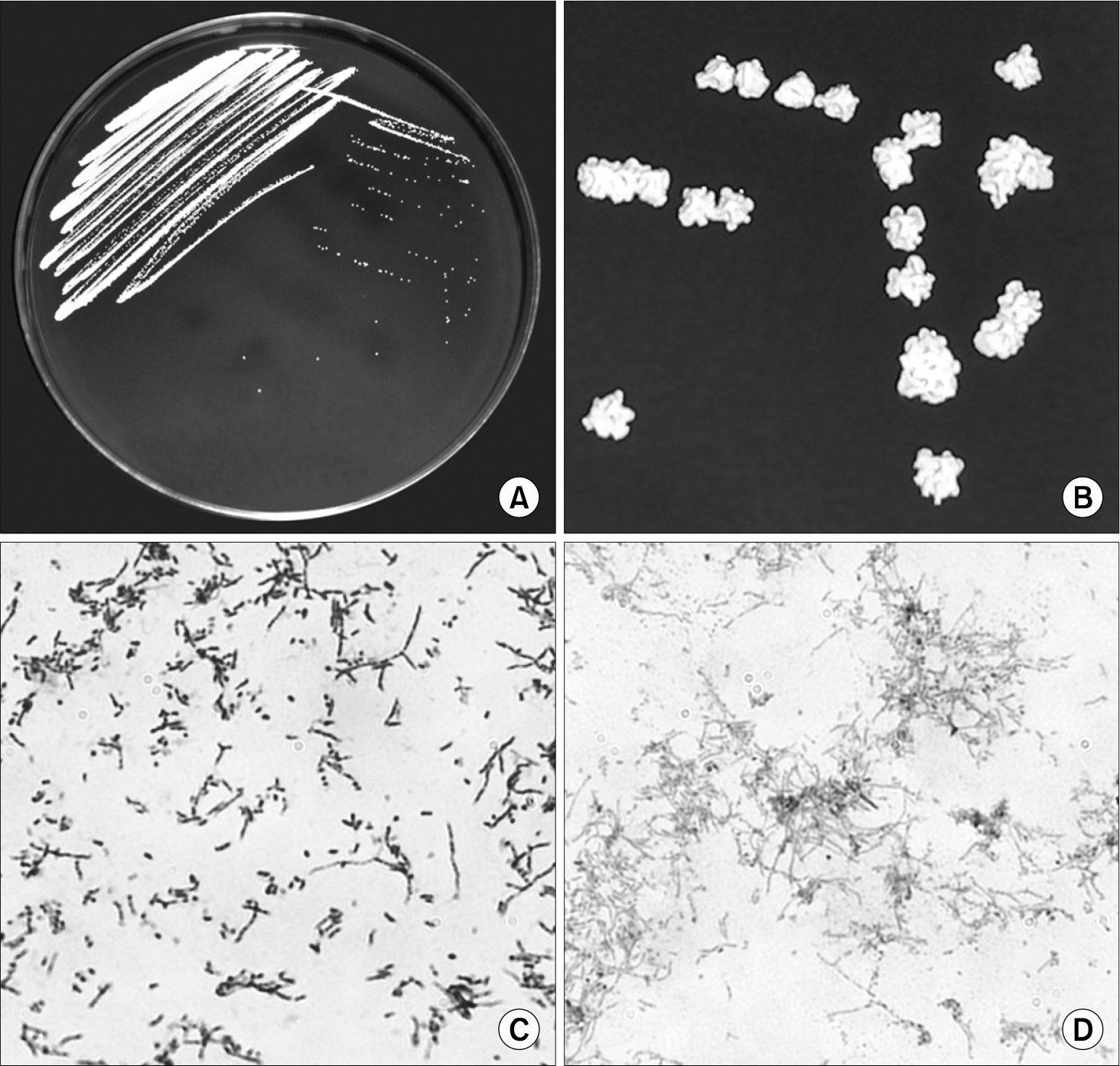Korean J Clin Microbiol.
2008 Oct;11(2):136-140. 10.5145/KJCM.2008.11.2.136.
A Strain of Nocardia cyriacigeorgica Isolated from a Patient with Pulmonary Infection
- Affiliations
-
- 1Department of Laboratory Medicine, Chosun University Medical School, Gwangju, Korea.
- 2Department of Radiology, Chosun University Medical School, Gwangju, Korea. yshkim@chosun.ac.kr
- 3Department of Research Center for Resistant Cells, Chosun University Medical School, Gwangju, Korea.
- 4Department of Microbiology, Chungang University Medical, Seoul, Korea.
- KMID: 1480983
- DOI: http://doi.org/10.5145/KJCM.2008.11.2.136
Abstract
- Nocardia cyriacigeorgica is an aerobic gram-positive rod that has mostly been reported as an opportunistic pathogen. Since molecular methodologies were introduced to identify species, infections caused by N. cyriacigeorgica have been reported. The patient was a 51-year-old woman with aplastic anemia, systemic lupus erythematosus, and disseminated tuberculosis, who was admitted to Chosun University Hospital with a history of fever and productive cough. During her hospitalization, sputum cultures were taken and a bacterium suspicious of acitinomycetes grew five times. It was a gram-positive rod that was also partially acid-fast on modified Kinyoun stain and resistant to lysozyme. After 24 h of incubation, cultures of the sputum onto sheep's blood agar plates (BAP) demonstrated rough, chalky, and white colonies with a characteristic earthy odor. Based on the above results, the presumptive identification of Nocardia species was made. To identify species of this isolate, 16S rRNA gene sequence analysis was taken and showed 99.9% homology to N. cyriacigeorgica DSM44484(T). The results of biochemical tests were compatible with other reports of N. cyriacigeorgica. As a result, this isolate was identified as N. cyriacigeorgica. Herein, we present a first report of N. cyriacigeorgica isolated from a patient with pulmonary infection in Korea.
MeSH Terms
Figure
Reference
-
References
1. Brown-Elliott BA, Brown JM, Conville PS, Wallace RJ Jr. Clinical and laboratory features of the Nocardia spp. based on current molecular taxonomy. Clin Microbiol Rev. 2006; 19:259–82.2. Laurent FJ, Provost F, Boiron P. Rapid identification of clinically relevant Nocardia species to genus level by 16S rRNA gene PCR. J Clin Microbiol. 1999; 37:99–102.3. Yassin AF, Rainey FA, Steiner U. Nocardia cyriacigeorgici sp. nov. Int J Syst Evol Microbiol. 2001; 51:1419–23.
Article4. Roth A, Andrees S, Kroppenstedt RM, Harmsen D, Mauch H. Phylogeny of the genus Nocardia based on reassessed 16S rRNA gene sequences reveals underspeciation and division of strains classified as Nocardia asteroides into three established species and two unnamed taxons. J Clin Microbiol. 2003; 41:851–6.5. Wauters G, Avesani V, Charlier J, Janssens M, Vaneechoutte M, Delmee M. Distribution of Nocardia species in clinical samples and their routine rapid identification in the laboratory. J Clin Microbiol. 2005; 43:2624–8.6. Schlaberg R, Huard RC, Della-Latta P. Nocardia cyriacigeorgica, an emerging pathogen in the United States. J Clin Microbiol. 2008; 46:265–73.7. Conville PS and Witebsky FG. Organisms designated as Nocardia asteroides drug pattern type VI are members of the species Nocardia cyriacigeorgica. J Clin Microbiol. 2007; 45:2257–9.8. Kim IT, Lee CK, Kim YK, Lee KN. Nocardia asteroides complex isolated from cerebrospinal fluid and surgical wound site: three case reports. Korean J Clin Pathol. 1997; 17:296–302.9. Jang SJ, Moon DS, Park YJ, Park JP, Lee HK, Yang NU. Subcutaneous abscess caused by Nocardia otitidiscaviarum. Korean J Infect Dis. 1991; 23:131–7.10. Park TB, Song YG, Kim SD, Jung ST, Hwang SC, Lee YH, et al. A case of pulmonary infection with Nocardia caviae. Ajou Med J. 1996; 1:394–9.11. Baek YH, Kim YJ, Lee HH, Youm JI, Kwon OW, Kim JH, et al. A case of intramuscular abscess caused by Nocardia farcinica in a patient with lupus nephritis concurrent with pulmonary tuberculosis. J Korean Rheum Assoc. 2006; 13:327–32.12. Wallace RJ Jr, Steele LC, Sumter G, Smith JM. Antimicrobial susceptibility patterns of Nocardia asteroides. Antimicrob Agents Chemother. 1988; 32:1776–9.
Article13. Yoo SY, Kim KJ, Lim SH, Kim KW, Hwang HK, Min BM, et al. First isolation of Streptococcus downei from human dental plaques. FEMS Microbiol Lett. 2005; 249:323–6.14. Clinical Laboratory Standards Institute. Interpretive criteria for identification of bacteria and fungi by DNA target sequencing; Approved guideline. Document MM18-A. Wayne, PA; Clinical Laboratory Standards Institute. 2008.15. Conville P and Witebsky FG. Current issues pertaining to the Nocardia species. Clinical Microbiology Newsletter. 2004; 26:57–62.
Article16. Stackebrandt E, Rainey FA, Ward-Rainey NL. Proposal for a new hierarchic classification system, Actinobacteria classis nov. Int J Syst Evol Microbiol. 1997; 47:479–91.
Article17. Akcaglar S, Ersoy C, Yilmaz E, Heper Y, Alver O, Akalin H, et al. Nocardia cyriacigeorgica: pulmonary infection in a patient with Basedow-Graves disease and a short review of reported cases. Int J Infect Dis. 2008; 12:335–8.
Article18. Kageyama A, Hoshino Y, Yazawa K, Poonwan N, Takeshita N, Maki S, et al. Nocardia cyriacigeorgica is a significant pathogen responsible for nocardiosis in Japan and Thailand. Mycopathologia. 2005; 160:15–9.
Article
- Full Text Links
- Actions
-
Cited
- CITED
-
- Close
- Share
- Similar articles
-
- Nocardia asteroides complex Isolated from Cerebrospinal Fluid and Surgical Wound Site: Three Case Reports
- Streptococcus salivarius pneumonia with pulmonary nocardiosis in a rheumatoid arthritis patient treated with immunosuppressants
- Multiple Intramuscular Abscesses Caused by Nocardia abscessus in a Patient with Chronic Obstructive Lung Disease: Clinical Microbiology Considerations
- A Case of Nocardia asteroides Isolated from Subcutaneous Abscess in a Pneumonic Patient with a Rejected Transplant Kidney
- Severe Sepsis and Empyema Caused by Nocardia


